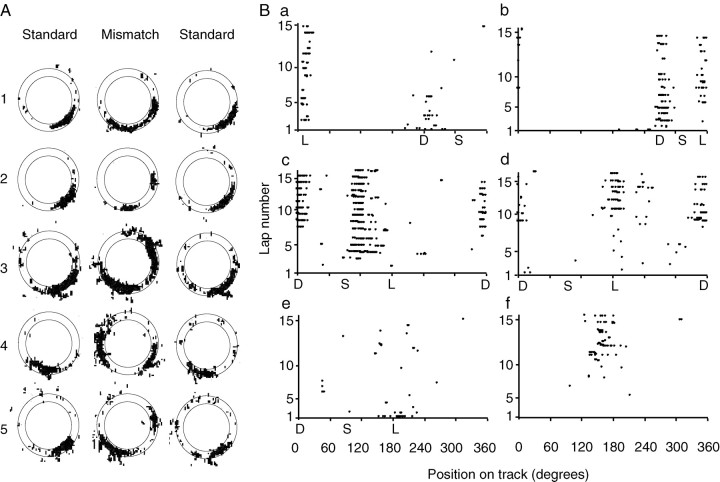Fig. 4.
Split place fields. A, Examples of five cells that split their place fields in the mismatch session.B, Examples of six cells that displayed dynamic changes in their place fields over the time course of a mismatch session.S indicates the location of the place field in the previous standard session, L indicates the location corresponding to precise control by local cues, and Dindicates the location corresponding to precise control by distal cues. Note that because the circular track is plotted along the abscissa, there is a wraparound effect for cells c andd. Cell a initially fired at theD location for the first two laps and then fired at both the D and L locations for the next few laps, and eventually fired almost exclusively at the Llocation for the remainder of the session. Cell b (same cell as cell a in a later session) fired initially at the D location and then developed a split field at both the D and L locations. Cellc initially was silent and then after two laps began to fire in between the S and Llocations. Midway through the session, it developed a split field, firing at the D location as well. (In the subsequent standard and mismatch sessions, this cell lost its strong spatial tuning.) Cell d was fairly quiet for the first eight laps and then began to fire at both the L andD locations. (In the second mismatch session of the day, the place field of cell d was controlled only by the distal cues, but the strength of the field changed over time; it started out weak, became strong for 5–6 laps, and then became weaker again.) Cell e had a strong field at theL location on the first lap only and then became relatively quiet. Cell f was quiet for the first 10 laps and then developed a completely new field near the end of the session. (A shift in the recording electrode after the subsequent standard session made it impossible to determine what cells e andf did on the second mismatch session of the day.)

